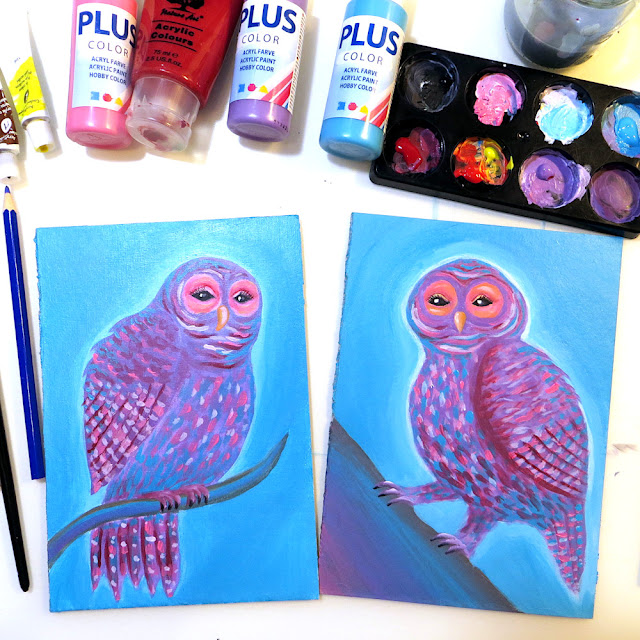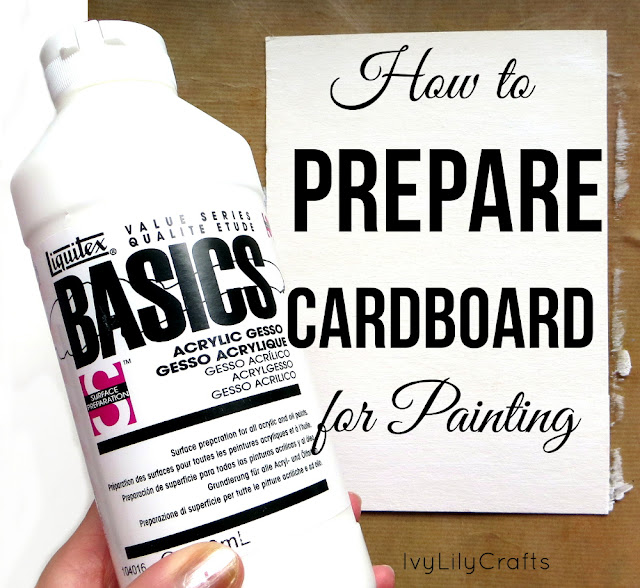Do You Have to Prime Cardboard Before Painting?
Do you really need to prime cardboard with gesso before painting? I previously made a blog post about how I prepare cardboard for painting by priming it with gesso and why you might want to do that. This time I'm testing, if you really have to prime it by showing you a comparison of painting on primed and unprimed cardboard with acrylics. Let's see if the primed vs. unprimed cardboard painting results look different or not and whether I'll be contradicting what I wrote in that post.
You can watch the video version of the primed vs. unprimed cardboard comparison or continue reading below.
Cutting the cardboard
I cut up the cardboard into two pieces, so you can get a fair comparison. It's the backing of a watercolor pad, so it's quite thick. So, I had to use a utility knife to cut it in half and then a nail file to smooth out the cut, because I couldn't get a clean cut. Then I used little nail scissors to clean off the rest. I've used up a few of these same watercolor pads before and I like painting on their cardboard backings because they're sturdy and don't bend that much, but I wouldn't normally cut them up like this. I did this just so you can get a comparison with the exact same type and color of cardboard.
 |
| Original rough sketch and final watercolor pencil sketch of the owl on cardboard primed with gesso. |
Priming the cardboard with gesso
I primed one piece with Liquitex Basics white acrylic gesso* using two coats: one horizontal, one vertical. I let it dry for a couple of hours. I had two rough sketches of owls in my sketchbook and I freehand sketched them on the cardboard pieces with a watercolor pencil in a bigger size. I think the references I had were tawny owls, but I completely changed the color scheme. I wanted to use the same colors in both paintings, so they'd be comparable.
(* These links are affiliate/referral links that let you support the blog at no extra cost to you.)
 |
| Owl sketches on cardboard. The primed cardboard is on the left and the unprimed cardboard is on the right. |
Acrylic painting on cardboard
The acrylic paints I was using were mostly Plus color paints, which are opaque. I also added a bit of other, more transparent paints as well. All the painting supplies are listed at the end of this post.
The first difference between the two paintings was that when I was painting on the unprimed cardboard, it got wet. I could see the paint is soaking into it.
 |
| Painting the first background layer on unprimed and primed cardboard using opaque acrylic paint. |
I have to say the cardboard on its own is a smoother surface to paint on than gesso. The brush strokes don't show up as much on the unprimed surface. You can, however, sand down gesso lightly with fine sand paper to make it smoother in between the layers and after the final gesso layer. I usually don't bother doing that, but it could've made a difference here.
Also, in the beginning stages, the primed painting looked shinier, while the unprimed painting definitely looked more matte in the first layer.
The experiences I've had before with painting on unprimed cardboard were using transparent acrylics. I've also painted on cardboard with Ikea Måla paints, which I thought were acrylics until I realized that they reactivate with water. I guess they were actually poster paints, but that's besides the point.
In both of those cases, I had trouble with getting the paint to look opaque. This time the paintings started to look very similar with a few layers, though. So, it also depends on the type of paints you're using. I think I had a better experience this time, because I was using only opaque acrylics or at least mixing the transparent acrylics with the opaque ones and I was layering them.
 |
| Finished owl painting on primed cardboard. |
Did I have to layer the unprimed painting more than the primed one to get it look the same? I can't really tell. Judging by the video footage I had, the owl on the unprimed cardboard took a bit longer to paint. But that might be, because I just wasn't happy with how it was looking and had to paint over some parts, not so much because the paint would not cover enough and I'd have to keep layering to get the same coverage as with the primed one.
 |
| Finished owl painting on unprimed cardboard. |
Results
So, when I was finished, it seemed that there was no difference at the end. You wouldn't be able to tell which one was primed and which one wasn't, but I can't tell how they would look over time, maybe in a few years.
 |
| Finished owl paintings side by side. Primed on the left and unprimed on the right. |
So, yes, can you paint on cardboard without priming it first. Yes, you can have the painting look exactly the same, but it depends on what you're planning to do with the painting.
Gesso creates a layer between the cardboard and the acrylic paints or oil paints so that they don't soak into the cardboard. Gesso is also going to protect the painting from a possible acidic surface. If the painting surface is not acid free, the painting will not last as long. It can go yellow over time.
It's your choice. Depends on whether you want the painting to last longer or if it's ok that it doesn't. If you're painting on cardboard, you already know it's going to degrade over time. It's not going to last forever whether you prime it or not. I'm interested to see how these two will last over the years compared to each other, though.
 |
| Prints, notebooks, clocks, home decor and other merch are available of both owl paintings in my Redbubble shop. |
Painting supplies
- Cardboard
- *Liquitex Basics acrylic gesso
- *Plus Color Craft Paint
- *Crelando Acrylic Colours
- *Ikea's Måla brush set
- *Gold line synthetic nailon brushes
- *Acrylic painting supplies I use in my Amazon affiliates shop







Comments
Post a Comment